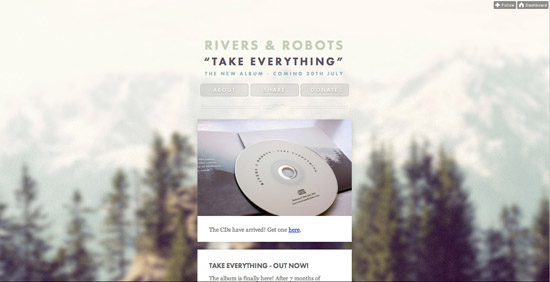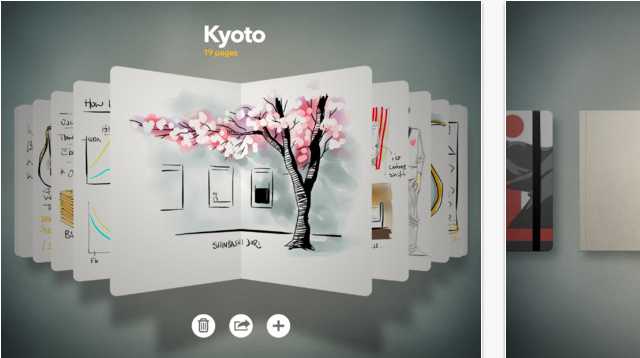During the two days of the Smashing Conference, we provide you with insights, photos and highlights on Smashing Magazine — live from the conference venue. Our team will be posting updates from the early morning to the late evening on both dates to bring you as close to the conference as possible. You can also track the tweets from the conference by following the hashtag #smashingconf and permalink for the live updates.
Bookmark this page to follow the updates in real-time. Please notice that no live stream is available, but all videos will be made available for free after the event. You might want to check the schedule of the conference as well and the report from day 1.
Tuesday, September 18th 2012
12.15
The opening titles for the Smashing Conference are now available online. Designed by the fantastic team by JoaquÃn Urbina from No-Domain from Barcelona, Spain. Thank you, guys, for the fantastic work!
© Smashing Editorial for Smashing Magazine, 2012.
20.37
And that’s it. The conference is over, and it was a truly fantastic, smashing experience. It was such a pleasure meeting so many talented, hard-working people, and it’s so rewarding to meet attendees saying that the conference inspired them a lot. That’s why we wanted to create a conference in the first place.
Thanks to everybody involved, speakers, our fantastic team, sponsors and attendees. Thank you, Marc for your help and your fantastic input! And let’s see what the next year will bring!
© Smashing Editorial for Smashing Magazine, 2012.
19.05
“A tool that Adobe… yes, Adobe, the company that gave us Flash and other diseases.” — Christian Heilmann
© Smashing Editorial for Smashing Magazine, 2012.
18.49
“Things without single points of failure are more sustainable. Great argument for web over native platforms.” — Christian Heilmann
© Smashing Editorial for Smashing Magazine, 2012.
18.43
“We need access to the metal. JavaScript has to talk to the hardware only then we have a fair comparison.” — Christ Heilmann
© Smashing Editorial for Smashing Magazine, 2012.
18.41
“Firefox OS is (partly) written in JS. So you alter the height of the keytones in an Javascript-Array. If you want to.” — Christian Heilmann
© Smashing Editorial for Smashing Magazine, 2012.
18.40
“Emulation brings frustration. Web apps cannot be native apps and shouldn’t try. Too many people don’t understand that.” — Christian Heilmann
© Smashing Editorial for Smashing Magazine, 2012.
18.36
“With all these Javascript MVC frameworks and hardcore development, it’s easy to feel obsolete and stupid.” — Christian Heilmann
© Smashing Editorial for Smashing Magazine, 2012.
18.23
Christian Heilmann actually titled his talk “To Be Announced”. Now, if that’s not confusing, what is?

© Smashing Editorial for Smashing Magazine, 2012.
18.21
The conference is coming to an end. The last talk by Christian Heilmann.


© Smashing Editorial for Smashing Magazine, 2012.
17.30
“Craft is a vehicle to put a little bit of ourselves into the things we make.” — Aarron Walter
© Smashing Editorial for Smashing Magazine, 2012.
17.24
“Make better things in a better way.” — Raleigh Denim by Aarron Walter.
© Smashing Editorial for Smashing Magazine, 2012.
17.18
“Falling in love with your tools is a dangerous thing, because you lose the focus of communicating.” — Aarron Walter
© Smashing Editorial for Smashing Magazine, 2012.
17.17
Aarron Walter is speaking about the importance of personality and voice in design.

© Smashing Editorial for Smashing Magazine, 2012.
16.37
“To load the Facebook, Twitter and Google Social Media buttons for a total of 19 requests takes 246.7K in bandwidth”. — Brad Frost
© Smashing Editorial for Smashing Magazine, 2012.
16.36
“There are so many ways to design a responsive carousel in a wrong way. If possible, avoid them at all costs.” — Brad Frost
© Smashing Editorial for Smashing Magazine, 2012.
16.25
“Today’s landscape is boot camp for tomorrow’s insanity.” — Brad Frost on responsive design.
© Smashing Editorial for Smashing Magazine, 2012.
16.19
Mobitest: a free mobile Web performance measurement tool.
© Smashing Editorial for Smashing Magazine, 2012.
16.19
“Performance is invisible. You can’t mock up performance in Photoshop.” — Brad Frost
© Smashing Editorial for Smashing Magazine, 2012.
16.17
Brad Frost on the stage. “Embrace the squishiness.”
“71% of mobile users expect mobile sites to load as fast if not faster than desktop sites.” — Brad Frost


© Smashing Editorial for Smashing Magazine, 2012.
16.12
“Ubiquity is Web’s superpower.” — Brad Frost
“Diversity is not a bug… It’s an opportunity.” — Stephanie Rieger
© Smashing Editorial for Smashing Magazine, 2012.
15.33
“Don’t code CSS for the page. Code it for the system. Naming convention clarifies intent. Use child selectors, please!” — Jonathan Snook
© Smashing Editorial for Smashing Magazine, 2012.
15.21
“Use class over ID. Don’t use a grenade when a shovel will do.” — Jonathan Snook
© Smashing Editorial for Smashing Magazine, 2012.
15.19
“Define what’s going to apply to 90% of the use cases and then figure out what the variations are. Embrace the cascade.” — Jonathan Snook
© Smashing Editorial for Smashing Magazine, 2012.
15.17
Photos from the Smashing Conference. The atmosphere was fantastic!




























© Smashing Editorial for Smashing Magazine, 2012.
15.12
Jonathan Snook is talking about the techniques and strategies to improve the structure and ease maintenance of CSS.

© Smashing Editorial for Smashing Magazine, 2012.
15.09
“It’s a good idea to check the CSS of your site when you are done and see what happens if you remove reset.css. Quite often, not a bit will change.” — Jonathan Snook
© Smashing Editorial for Smashing Magazine, 2012.
14.35
“Problem is that designers look, they don’t read.” — Tim Ahrens
© Smashing Editorial for Smashing Magazine, 2012.
14.31
“If you use uppercase in your designs, you should almost always increase the letter-spacing in CSS.” — Tim Ahrens
© Smashing Editorial for Smashing Magazine, 2012.
14.12
Tim Ahrens is speaking about Web fonts. “Today I am the font guy on a web conference. Normally I am the web guy at font conferences.” — Tim Ahrens.

© Smashing Editorial for Smashing Magazine, 2012.
12.44
“The DNA of the Web is a fluid, hyperlinked document with default typographic hierarchy.” — Josh Brewer
© Smashing Editorial for Smashing Magazine, 2012.
12.43
Josh Brewer mentioned Oliver Reichenstein’s article Web Design Is 95% Typography and Oliver Reichenstein sitting right on the stage.

© Smashing Editorial for Smashing Magazine, 2012.
12.39
Josh Brewer on stage, talking about the most important qualities of type-based responsive design process.



© Smashing Editorial for Smashing Magazine, 2012.
11.56
A plenty of Instagram photos from the conference: Smashing Conference photos.
© Smashing Editorial for Smashing Magazine, 2012.
11.35
Lea Verou is showing the new CSS tricks. Audience goes nuts.

© Smashing Editorial for Smashing Magazine, 2012.
11.29
From @leaverou at #smashingconf . background-attachment : local; Mind. Exploded.
— Andy Clarke (@Malarkey) September 18, 2012
© Smashing Editorial for Smashing Magazine, 2012.
10.25
“We need to have combined design and development processes that facilitates iteration.” — Andy Clarke
© Smashing Editorial for Smashing Magazine, 2012.
10.21
“It’s impossible to predict all the complications of a responsive design up front. We need a more fluid workflow.” — Andy Clarke

© Smashing Editorial for Smashing Magazine, 2012.
10.19
“We treat responsive design as a creative challenge, but it’s more of a business problem. Others need to be bothered.” — Andy Clarke
© Smashing Editorial for Smashing Magazine, 2012.
10.19
Andy Clarke on stage. “Rigid waterfall processes needs to fucking die. UX > Visual > Development > Implementation doesn’t work for responsive Web design.”

© Smashing Editorial for Smashing Magazine, 2012.
09.51
Freiburg greets us with fantastic weather again. The room is getting filled with attendees. And that although some of them had a long party yesterday! 15 minutes left until the second day starts.



© Smashing Editorial for Smashing Magazine, 2012.
07.11
The first day of the Smashing Conference was a truly remarkable experience. Jeremy Keith reminded us about what the true nature of the Web is; Rachel Andrew spoke about the challenges of modern content management systems; Stephen Hay introduced us to the ways designers can use command line to create style guides; Oliver Reichenstein proposed that a beautiful design is neither new nor nostalgic — it’s a continuous iteration taking place in small steps.
Nicole Sullivan provided some (deep) insights into her experience with SASS and OOCSS; Paul Boag reminded us that we should solve clients’ problems first and not design just for the users; Jake Archibald managed to explain the topic as dry as Appcache in a (comprehensive) diagram with a grain of fantastic British humor; and Mark Boulton reminded us that trends aren’t important in Web design, and that we should go beyond that to create meaningful, beautiful things. His experience in CERN, Switzerland, was a great introduction to the Smashing party afterwards, and apparently, he is quite fond of his personal heroes: “Bob Ross is the reason why I’m a designer”. Image credit.

The party afterwards was a great opportunity to meet the attendees, grab a beer and enjoy the conversations. The music was too loud at times, but the free beer made sure that the atmosphere is fantastic. And yes, we even had a Smashing Cocktail! Most attendees will probably wake up with a hangover, but we’re prepared for that. The coffee will be ready when the doors of the conference open for the second day!

© Smashing Editorial for Smashing Magazine, 2012.
We’re extremely excited and happy to welcome 16 fantastic speakers such as Andy Clarke, Rachel Andrew, Aarron Walter, Christian Heilmann, Jeremy Keith, Oliver Reichenstein, Lea Verou, Mark Boulton or Paul Boag as well as remarkable attendees from all parts of the world. The conference is a big deal for us, but we want you to be a part of it as well.
During the two days of the Smashing Conference, we will provide you with insights, photos and highlights from the conference venue live on Smashing Magazine website. Our team will be posting updates from the early morning to the late evening on both dates to bring you as close to the conference as possible. You can also track the tweets from the conference by following the hashtag #smashingconf.
Bookmark this page to follow the auto-updates in real-time. Please notice that no live stream is available, but all videos will be made available for free after the event.
The conference takes place in Freiburg, Germany at the legendary Historical Merchants Hall at the foot of the Black Forest. The two-day single-track conference will present talks on September 17th and 18th, as well as three workshops on September 19th.
Facts
- The Smashing Conference is a friendly, valuable and inspiring community event that will help designers and developers become better in their work, be it front- or back-end development, UX design, content strategy or running a business.
- Dates: 17–19 September 2012 (workshops on the 19th, and conference on the 17th and 18th).
- Twitter: @smashingconf
- Lanyrd: http://lanyrd.com/2012/smashingconf/
- Facebook: http://www.facebook.com/smashingconf
- Website: http://www.smashingconf.com
We’re very excited about the Smashing Conference, and we wish you attended the conference as well. Please share in the comments what exactly you’d like us to post, and feel free to submit your questions for speakers as well. We’re looking forward to the two inspiring and exciting conference days!










































































































